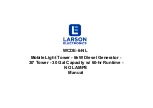
doepfer
System A - 100
MCV 16
A-191
15
Fig. 7
: Shepard tone patch
To help understand this weird science, just picture the
lowest harmonic of the tone (with the Shepard genera-
tor in its "Up" mode).
It starts inaudible, but as its pitch goes up, so does its
volume. By the time it gets to the middle of the audio
spectrum it is at its maximum amplitude, and will then
gradually get quieter again, until the highest frequency
is reached, and it’s inaudible again.
Meanwhile, other harmonics have been replacing it,
starting very quietly at the lowest frequency.
All eight of the VCOs in the Shepard tone produce
these ‘layered’ harmonics, re-starting at the bottom
once they’ve reached the highest frequency. The
result is, to our ears, a tone which is rising all the time,
but never gets any higher! The same applies in the
“down” mode, with the tone this time seeming to fall
continuously.
Shepard control of signal processing modules
The Shepard generator is useful not just for these
constantly rising or falling tones, but also to
control
modules which are
signal modifiers
.
Fig. 8 shows the standard patch - this time, instead of
VCOs, using signal processing units, like phasers or
filters, and patching an audio signal into them to be
processed. Phasers, in particular, produce a wonder-
fully unique effect, far richer and more animated than a
standard phaser.
VCO 1
VCA 1
Out
1
S 0
T 0
VCO 2
VCA 2
S 45
T 45
VCO 8
VCA 8
S 315
T 315
A-191
Out
2
Out
8


































